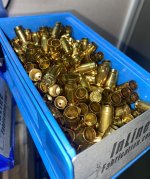What do you do when the flash hole is too small for easy depriming? I ordered a quantity of once fired .357 Sig mixed brass and I'm in the process of decapping it on my Lee APP. All of the Speer brass has flash holes that are too small for the decapping pin to easily pass through. At first I thought it was tight primer pockets, but on the few I've managed to decap, the pin is still very tight in the flash hole. The APP is great for fast decapping, but it's a little flimsy, so I haven't tried to force them. Luckily, the Speer only make up about 10% of the total so far.
What does one do in this situation? Scrap the brass? I'm using an RCBS universal decapping die…do they make a more slender decapping pin?
What does one do in this situation? Scrap the brass? I'm using an RCBS universal decapping die…do they make a more slender decapping pin?


